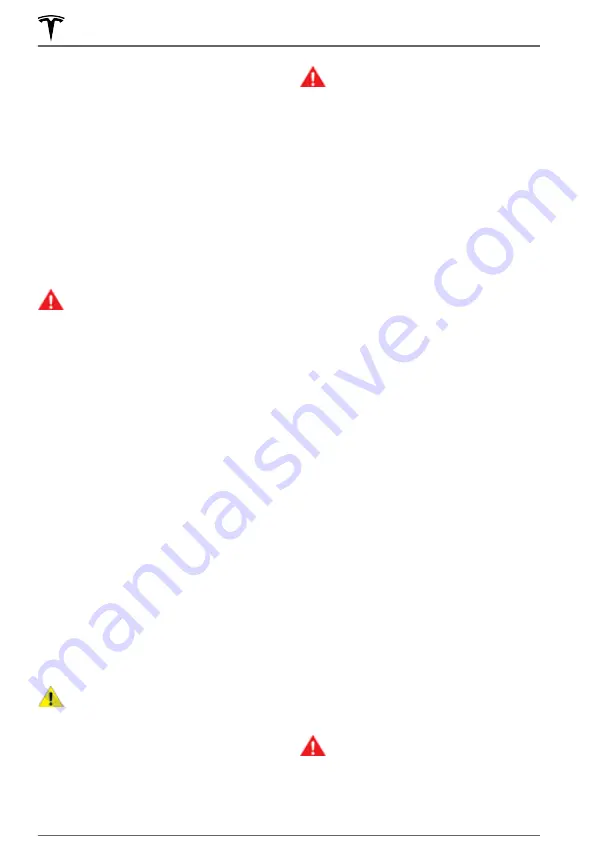
Dynamic Brake Lights (if equipped)
If you are driving over 30 mph (50 km/h) and
brake forcefully (or if Automatic Emergency
Braking engages), the brake lights flash
quickly to warn other drivers that Model X is
rapidly slowing down. If Model X stops
completely, the hazard warning lights flash.
Flashing continues until you press the
accelerator or manually press the hazard
lights button to turn them off (see
NOTE:
When towing a trailer (if applicable),
the brake lights on the trailer also operate as
described above, even when the trailer is not
equipped with a separate braking system.
WARNING:
When towing a trailer (if
applicable), always increase your
following distance. Sudden braking
may result in skidding, jack-knifing,
and loss of control.
Brake Disc Wiping
To ensure brakes remain responsive in cold
and wet weather, Model X is equipped with
brake disc wiping. When cold and wet
weather is detected, this feature repeatedly
applies an imperceptible amount of brake
force to remove water from the surface of the
brake discs.
Hydraulic Fade Compensation
Model X is equipped with hydraulic fade
compensation. This assists in monitoring
brake system pressure and ABS activity for
instances of reduced brake performance. If
reduced brake performance is detected (for
example, as a result of brake fade, or cold or
wet conditions), you may hear a sound, feel
the brake pedal pull away from your foot, and
notice a strong increase in braking. Brake as
you normally would and continue to press the
brake pedal without releasing or pumping the
brakes.
CAUTION:
If brakes are not
functioning properly, stop the vehicle
when safety permits and contact Tesla
Service.
WARNING:
Always maintain a safe
driving distance from the vehicle in
front of you and exercise caution
when driving conditions are
hazardous. Brake disc wiping and
hydraulic fade compensation is not a
substitute for adequately applying the
brakes.
Hydraulic Boost Compensation
Model X is equipped with a brake booster
that activates the brakes when the brake
pedal is pressed. Hydraulic boost
compensation provides mechanical assistance
if the brake booster fails. If a brake booster
failure is detected, the brake pedal feels
stiffer to press and you may hear a sound
when you press the brake pedal. To stop
Model X, apply steady force to the brake
pedal without releasing or pumping. Drive
cautiously and maintain a safe distance from
other road users—brake pedal responsiveness
and braking performance may be degraded.
Regenerative Braking
Whenever Model X is moving and your foot is
off the accelerator, regenerative braking slows
down Model X and feeds any surplus energy
back to the Battery.
By anticipating your stops and reducing or
removing pressure from the accelerator pedal
to slow down, you can take advantage of
regenerative braking to increase driving
range. Of course, this is no substitute for
regular braking when needed for safety.
NOTE:
Installing winter tires with aggressive
compound and tread design may result in
temporarily-reduced regenerative braking
power. However, your vehicle is designed to
continuously recalibrate itself, and after
changing tires it will increasingly restore
regenerative braking power after some
moderate-torque straight-line accelerations.
For most drivers this occurs after a short
period of normal driving, but drivers who
normally accelerate lightly may need to use
slightly harder accelerations while the
recalibration is in progress.
WARNING:
In snowy or icy conditions
Model X may experience traction loss
during regenerative braking.
Braking and Stopping
78
MODEL X Owner's Manual
Содержание MODEL X 2021
Страница 1: ...MODEL X 2021 OWNER S MANUAL Software version 2022 12 North America...
Страница 318: ...Publication date 2022 4 14...






























